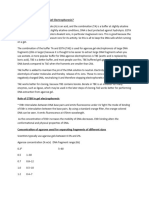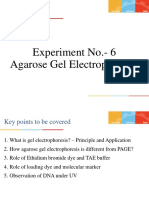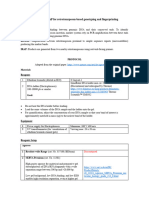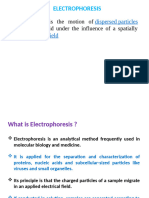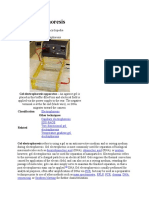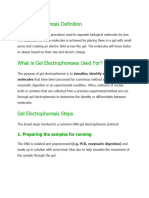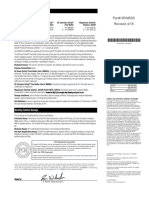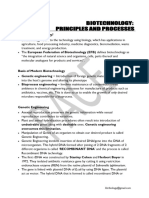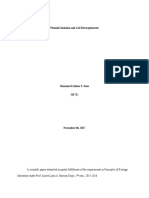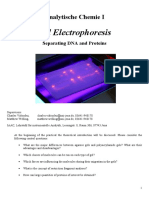Chapter 8
Chapter 8
Uploaded by
THỊNH HUỲNH LÊ ĐỨCCopyright:
Available Formats
Chapter 8
Chapter 8
Uploaded by
THỊNH HUỲNH LÊ ĐỨCCopyright
Available Formats
Share this document
Did you find this document useful?
Is this content inappropriate?
Copyright:
Available Formats
Chapter 8
Chapter 8
Uploaded by
THỊNH HUỲNH LÊ ĐỨCCopyright:
Available Formats
Chapter 8: Agarose Gel Electrophoresis Method
Objectives
After completing this lesson, learners will be able to:
1. Prepare an agarose gel electrophoresis system.
2. Analyze nucleotide sequences (PCR products, DNA, RNA) using agarose gel
electrophoresis.
8.1 Introduction
Electrophoresis is a technique that uses an electric field to separate mixtures of DNA, RNA, or
proteins on a three-dimensional network matrix. Nucleic acids, carrying a negative charge due to
the phosphate groups in their molecular structure, migrate towards the anode in an electric field.
The migration rate of nucleic acids through the matrix depends on their size and conformation.
The matrices used in electrophoresis include paper, cellulose acetate, starch gel, … Among them,
agarose gel and polyacrylamide gel are the most commonly used.
Agarose and agaropectin are the two main components of agar, which is extracted from seaweed.
Agarose is a linear polysaccharide composed of repeating disaccharide units of agarobiose. In
powdered form, agarose becomes hydrated and dissolves in water when heated above 85°C.
Upon cooling below 45°C, hydrogen bonds and electrostatic interactions between agarose
molecules form, creating a gel with a network structure. Agarose gel is chemically and
physically inert. The pore size of the gel varies depending on the concentration of agarose, which
allows for the separation of nucleic acids of different sizes (Table 8.1).
Electrophoresis on agarose gels is typically carried out horizontally, using a buffer system to
provide ions for current conduction, maintain pH, and inhibit nucleases that could degrade
nucleic acids during the run. The two most common buffer systems are TAE (Tris-acetate-
EDTA) and TBE (Tris-borate-EDTA). TAE is preferred for larger DNA fragments due to its
lower buffering capacity and minimal enzyme inhibition, whereas TBE, with its higher buffering
capacity and better resolution for small nucleic acids (< 2 kb), is suited for longer electrophoresis
runs. Consequently, TAE is often chosen for routine electrophoresis, while TBE is reserved for
more demanding applications.
Agarose gel electrophoresis is performed horizontally, with the gel submerged in running buffer,
thus referred to as horizontal submerged electrophoresis (Figure 8.1). The running buffer serves
to (1) provide ions to create a conductive environment; (2) stabilize pH to maintain the negative
charge of nucleic acids; and (3) inhibit nucleases to prevent nucleic acid degradation during
electrophoresis. The two common running buffers are TAE (Tris-acetate-EDTA) and TBE (Tris-
borate-EDTA). TAE buffer is used for analyzing large DNA and purifying DNA for cloning, as
borate in TBE can inhibit certain DNA-modifying enzymes. TBE buffer provides higher
resolution for nucleic acids smaller than 2 kb and has better buffering capacity than TAE,
making it suitable for longer electrophoresis runs.
You might also like
- Molecular Biology ExperimentDocument6 pagesMolecular Biology ExperimentWalwin Hare100% (1)
- Agarose Gel ElectrophoresisDocument7 pagesAgarose Gel ElectrophoresisMahathir Mohmed79% (14)
- Agarose Gel ElectrophoresisDocument5 pagesAgarose Gel ElectrophoresisSanmugam SubbaramaniamNo ratings yet
- ElectrophoresisDocument88 pagesElectrophoresissamhossain1907No ratings yet
- AGE FinalDocument19 pagesAGE FinalShravya SridharNo ratings yet
- Agarose GelsDocument8 pagesAgarose Gelsrapuenzal farooqiNo ratings yet
- ElectrophoresisDocument41 pagesElectrophoresisShowmiya NNo ratings yet
- Gel ElectrophoresisDocument2 pagesGel ElectrophoresisJinia DarlongNo ratings yet
- Agarose Gel Electrophoresis-1Document5 pagesAgarose Gel Electrophoresis-1Kanishk AgrawalNo ratings yet
- Electrophoresis (MDC)Document12 pagesElectrophoresis (MDC)kabilhoyahNo ratings yet
- Agerose Gel ElectrophoresisDocument6 pagesAgerose Gel ElectrophoresisAnura BandaraNo ratings yet
- Experiment No.-6 Agarose Gel ElectrophoresisDocument10 pagesExperiment No.-6 Agarose Gel ElectrophoresisAditya JhaNo ratings yet
- M Lec 04 Electrophoresis 12 OctDocument34 pagesM Lec 04 Electrophoresis 12 Octcr71911020No ratings yet
- Principles of Gel ElectrophoresisDocument6 pagesPrinciples of Gel ElectrophoresisCarmen Lopez100% (2)
- Agarose Gel ElectrophoresisDocument3 pagesAgarose Gel ElectrophoresisAbhijitBoruah100% (1)
- MCB 307 - 1Document15 pagesMCB 307 - 1marvelloussamuel771No ratings yet
- 1) Electrophoresis - IntroductionDocument12 pages1) Electrophoresis - IntroductionMuhammad AdeelNo ratings yet
- Agarose Gel ElectrophoresisDocument11 pagesAgarose Gel ElectrophoresisAbrar 111No ratings yet
- Agarose Gel ElectrophoresisDocument22 pagesAgarose Gel ElectrophoresisSagar Das ChoudhuryNo ratings yet
- Unit 2Document15 pagesUnit 2Anadi ChauhanNo ratings yet
- PROTOCOL - IRAP and REMAP For RetrotransposonDocument7 pagesPROTOCOL - IRAP and REMAP For RetrotransposonAngela JimenezNo ratings yet
- ElectrophoresisDocument59 pagesElectrophoresisnitinNo ratings yet
- Practical 06 MSC Botany MorningDocument4 pagesPractical 06 MSC Botany Morninghely shahNo ratings yet
- Resolution and Detection of Nucleic AcidsDocument43 pagesResolution and Detection of Nucleic Acidsvg04No ratings yet
- InTech Principles of Nucleic Acid Separation by Agarose Gel ElectrophoresisDocument8 pagesInTech Principles of Nucleic Acid Separation by Agarose Gel ElectrophoresisPesbuk BodongNo ratings yet
- 04-Gel ElectrophoresisDocument24 pages04-Gel ElectrophoresisBen Abella100% (1)
- ELECTROPHRESISDocument66 pagesELECTROPHRESISM.PRASAD NAIDU100% (1)
- Electrophoresis: Daheeya Alenazi Cls 332Document35 pagesElectrophoresis: Daheeya Alenazi Cls 332Terez ŠevčíkováNo ratings yet
- Ceb Practical: 1. TitleDocument8 pagesCeb Practical: 1. TitleKischa DoesesNo ratings yet
- Resolution and Detection of Nucleic AcidsDocument19 pagesResolution and Detection of Nucleic AcidsAdriana AvramNo ratings yet
- 5. Agarose gel مختبرDocument2 pages5. Agarose gel مختبرAbrar 111No ratings yet
- BCH 306 Electro - Chromatog - KSUSTA PDFDocument55 pagesBCH 306 Electro - Chromatog - KSUSTA PDFAbubakar SuleimanNo ratings yet
- ElectrophoresisDocument32 pagesElectrophoresisWajid MarwatNo ratings yet
- Practical-BIO231-Agarose Gel Electrophoresis-FKDocument5 pagesPractical-BIO231-Agarose Gel Electrophoresis-FKmalik husnainNo ratings yet
- Separation of DNA by Agarose Gel ElectrophoresisDocument3 pagesSeparation of DNA by Agarose Gel ElectrophoresisSathish kumarNo ratings yet
- S.Y.Bsc Semester Iii Botany Paper IiDocument53 pagesS.Y.Bsc Semester Iii Botany Paper IiĐỗ Quang BìnhNo ratings yet
- 2a.detection of Nucleic Acid - ElectrophoresisDocument74 pages2a.detection of Nucleic Acid - Electrophoresisqanitakhan2002No ratings yet
- Electrophoresis LabDocument3 pagesElectrophoresis LabghustoNo ratings yet
- Agarose Gel Electrophoresis of DNA PDFDocument5 pagesAgarose Gel Electrophoresis of DNA PDFBiologistAhmedNo ratings yet
- Typical DNA Recoveries From Agarose Gels DNA Size (BP) Percent DNA RecoveriesDocument5 pagesTypical DNA Recoveries From Agarose Gels DNA Size (BP) Percent DNA RecoveriesrjvtNo ratings yet
- Semi-Quantitative Analysisof Nucleic Acids On Agarose Gels With Choice of Beverages As Electrophoretic BufferDocument4 pagesSemi-Quantitative Analysisof Nucleic Acids On Agarose Gels With Choice of Beverages As Electrophoretic BufferIJAR JOURNALNo ratings yet
- Gel Electrophoresis - Wikipedia, The Free EncyclopediaDocument10 pagesGel Electrophoresis - Wikipedia, The Free EncyclopediaShailendra YadavNo ratings yet
- Gel Electrophoresis Apparatus - An Agarose Gel IsDocument5 pagesGel Electrophoresis Apparatus - An Agarose Gel IsUmair NazeerNo ratings yet
- ELECTROPHORESISDocument46 pagesELECTROPHORESISSri DurgaNo ratings yet
- ElectrophoresisDocument8 pagesElectrophoresisKanjana K BNo ratings yet
- Gel-Electrophoresis and Its Applications: April 2012Document19 pagesGel-Electrophoresis and Its Applications: April 2012darshitsingh9450No ratings yet
- Gel Electrophorosis MpatDocument19 pagesGel Electrophorosis Mpatkavya nainitaNo ratings yet
- Gel-Electrophoresis and Its Applications: Raju NomulaDocument19 pagesGel-Electrophoresis and Its Applications: Raju Nomulasic 20162085No ratings yet
- Gel-Electrophoresis and Its Applications: Raju NomulaDocument19 pagesGel-Electrophoresis and Its Applications: Raju NomulaAbdo MohdyNo ratings yet
- Cellulose AcetateDocument6 pagesCellulose AcetateMichel Yudi S. KanemaruNo ratings yet
- Exercise 7 Agarose Gel Electrophoresis: Cell and Molecular Biology LaboratoryDocument8 pagesExercise 7 Agarose Gel Electrophoresis: Cell and Molecular Biology LaboratoryDham DoñosNo ratings yet
- Separation: Gel Electrophoresis Is A Technique Used For The Separation of Deoxyribonucleic Acid (DNA)Document7 pagesSeparation: Gel Electrophoresis Is A Technique Used For The Separation of Deoxyribonucleic Acid (DNA)RobotrixNo ratings yet
- ElectrophoresisDocument31 pagesElectrophoresismuhammadhasnainshahidmltNo ratings yet
- Tools Used in Molecular BiologyDocument92 pagesTools Used in Molecular BiologyMayank AhirwarNo ratings yet
- Electrophoresis 1Document8 pagesElectrophoresis 1Rishabh MasutaNo ratings yet
- Simultaneous Monitoring of Glucose, Lactate, - Glutamate and Hypoxanthine Levels in Rat Striatum by A Ow-Injection Enzyme Electrode Array System With in Vivo Microdialysis SamplingDocument7 pagesSimultaneous Monitoring of Glucose, Lactate, - Glutamate and Hypoxanthine Levels in Rat Striatum by A Ow-Injection Enzyme Electrode Array System With in Vivo Microdialysis SamplingsggdgdNo ratings yet
- Gel Electrophoresis DefinitionDocument4 pagesGel Electrophoresis Definitionhyuga6552No ratings yet
- Gel Electrophoresis IDocument6 pagesGel Electrophoresis ISalvador MartinezNo ratings yet
- Lectin Affi Nity Electrophoresis: Yuka KobayashiDocument9 pagesLectin Affi Nity Electrophoresis: Yuka KobayashiDaniel GarciaNo ratings yet
- Experiment:5: Agarose Gel ElectrophoresisDocument16 pagesExperiment:5: Agarose Gel ElectrophoresisANKIT KUMARNo ratings yet
- Af9Pim500 0418M500 : Gotaq Hot Start PolymeraseDocument2 pagesAf9Pim500 0418M500 : Gotaq Hot Start Polymerasenbiolab6659No ratings yet
- Gel ElectrophoresisDocument33 pagesGel ElectrophoresisHindi PharmacyNo ratings yet
- FastPrep24 InformationDocument24 pagesFastPrep24 InformationAslam BalteeNo ratings yet
- Biotechnology - Principles and Processes - PACEDocument16 pagesBiotechnology - Principles and Processes - PACEHemanth Kumar GNo ratings yet
- Agarose Gel ElectrophoresisDocument3 pagesAgarose Gel ElectrophoresisAbhijitBoruah100% (1)
- Taha 2017Document9 pagesTaha 2017aufa QooNo ratings yet
- mcb130 Sci PaperDocument9 pagesmcb130 Sci PaperShannen SenaNo ratings yet
- RFLPDocument7 pagesRFLPSaifNo ratings yet
- 57 5 1 - BiologyDocument24 pages57 5 1 - BiologytejNo ratings yet
- Detection of White Root Rot in Avocado Trees by Remote SensingDocument7 pagesDetection of White Root Rot in Avocado Trees by Remote SensingJulian OtalvaroNo ratings yet
- Final Exam Review - 2023 - TaggedDocument18 pagesFinal Exam Review - 2023 - Taggedcanalescp9No ratings yet
- Gotaq Green Master Mix ProtocolDocument2 pagesGotaq Green Master Mix ProtocolJuan Pablo CuevaNo ratings yet
- Ape Lex 2015Document106 pagesApe Lex 2015Bolawali KiNo ratings yet
- Moller Et Al 2020Document10 pagesMoller Et Al 2020FellipNo ratings yet
- Gel Electrophoresis Power SupplyDocument9 pagesGel Electrophoresis Power Supplyمحمود صالح محمود عليNo ratings yet
- Techniques in Mol Biology Lab ManualDocument35 pagesTechniques in Mol Biology Lab ManualBalew GetaNo ratings yet
- AmaR One PCRDocument2 pagesAmaR One PCRWang EvanNo ratings yet
- Maibeche2022 Article Peroxidase-producingActinobactDocument18 pagesMaibeche2022 Article Peroxidase-producingActinobactyousraadl10No ratings yet
- Bio Paper 5 PDFDocument8 pagesBio Paper 5 PDFManha KhalidNo ratings yet
- Seleksi in Vitro Tanaman Jagung (Zea Terhadap Cekaman SalinitasDocument106 pagesSeleksi in Vitro Tanaman Jagung (Zea Terhadap Cekaman SalinitasYova NaiboasNo ratings yet
- Isolation and Characterization of Rhizobacteria From ChilliDocument15 pagesIsolation and Characterization of Rhizobacteria From ChillisauravNo ratings yet
- GENETICSDocument26 pagesGENETICSANIRBAN PALNo ratings yet
- Bambara Groundnut PDFDocument49 pagesBambara Groundnut PDFd.orreenselcouthNo ratings yet
- Electrophoresis 1Document22 pagesElectrophoresis 1Dr Sachin PandeyNo ratings yet
- Assessment of Microbiological Activities of Empurau Fish (Tor Tambraides) of Local Fish Farm (24pgs)Document24 pagesAssessment of Microbiological Activities of Empurau Fish (Tor Tambraides) of Local Fish Farm (24pgs)Karolina DermawanNo ratings yet
- Gel Electrophoresis PDFDocument13 pagesGel Electrophoresis PDFagromusicNo ratings yet
- Elektroforesis: Analisis Elektronika Terhadap Biokimia GenetikaDocument7 pagesElektroforesis: Analisis Elektronika Terhadap Biokimia GenetikaFirliana Ayu OktafiaNo ratings yet
- Santillan 2017Document11 pagesSantillan 2017Miguel RamirezNo ratings yet
- Immunology Lab ProceduresDocument27 pagesImmunology Lab ProcedureschitraNo ratings yet







